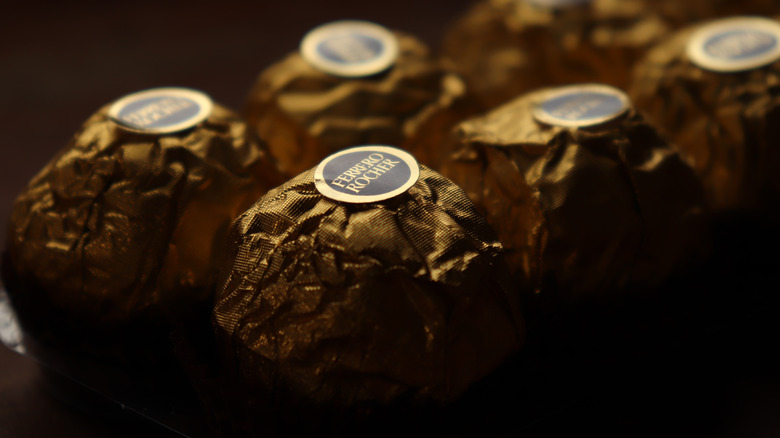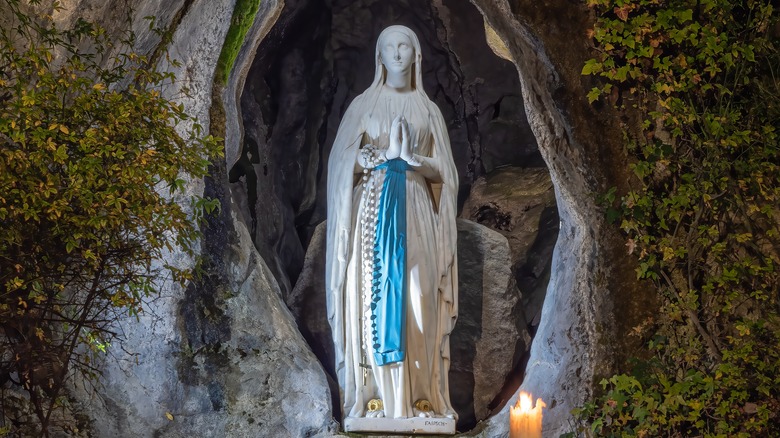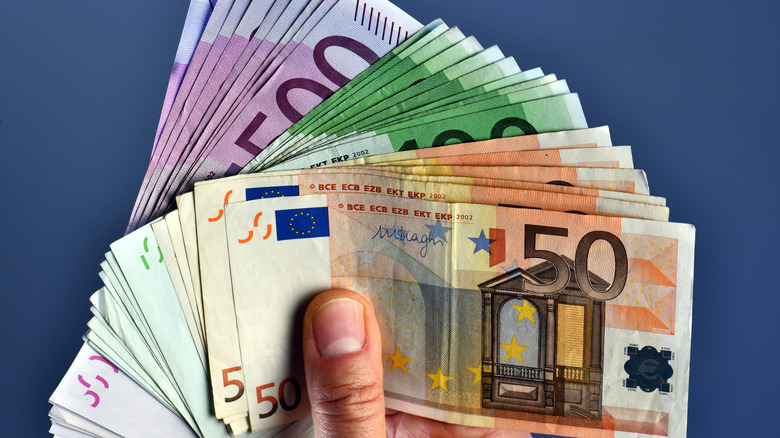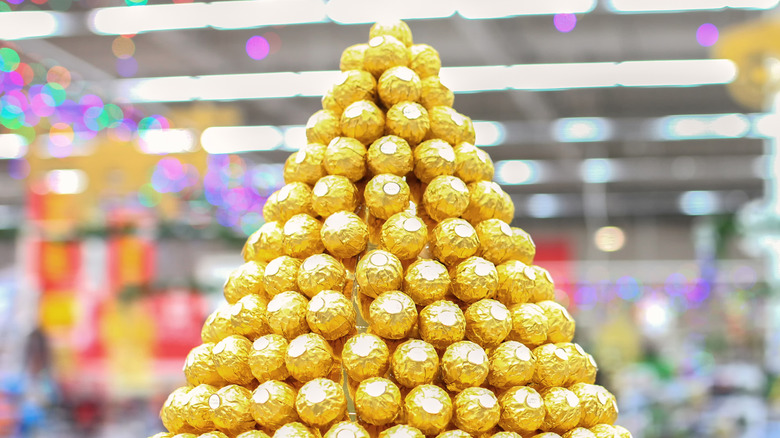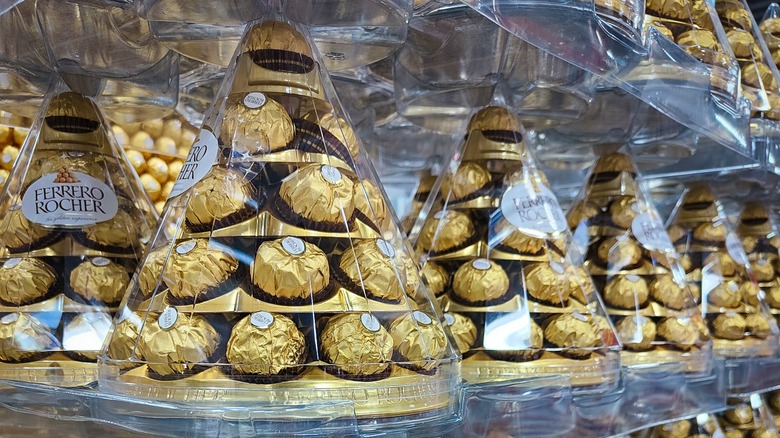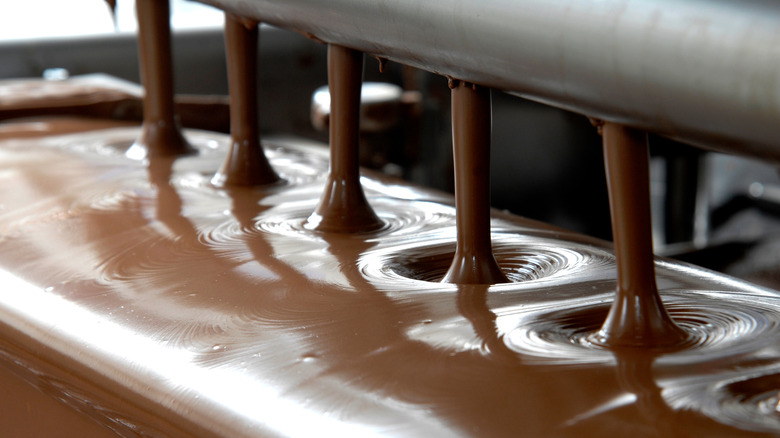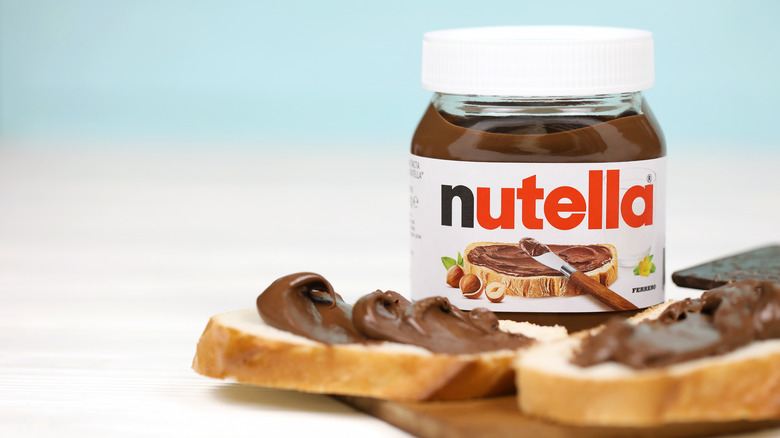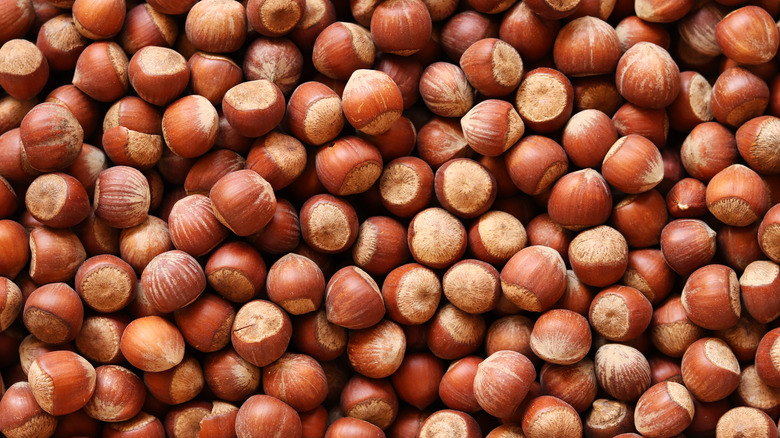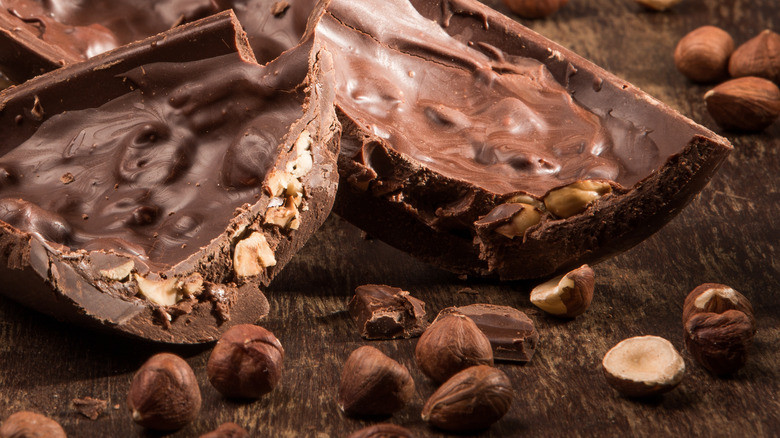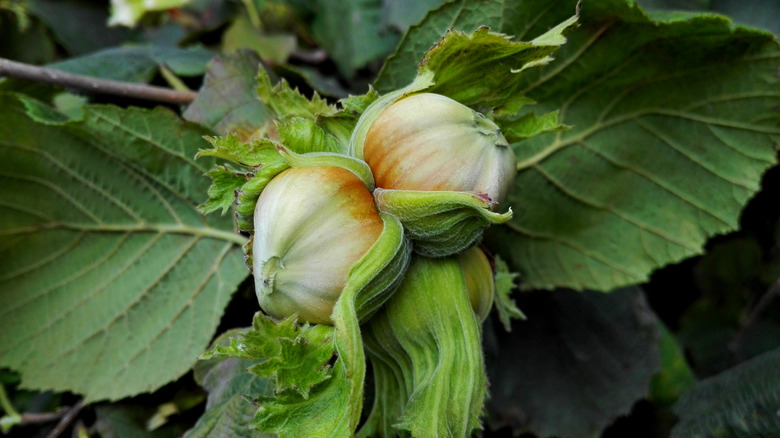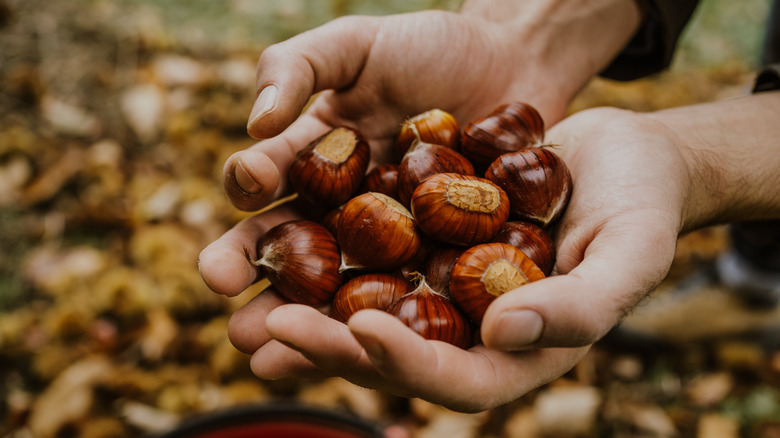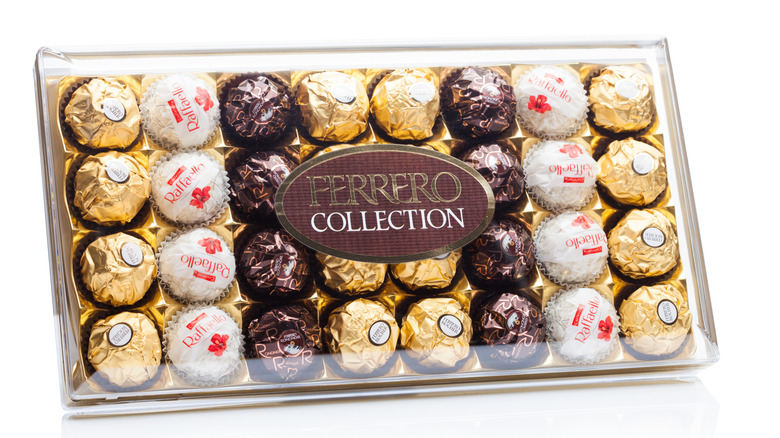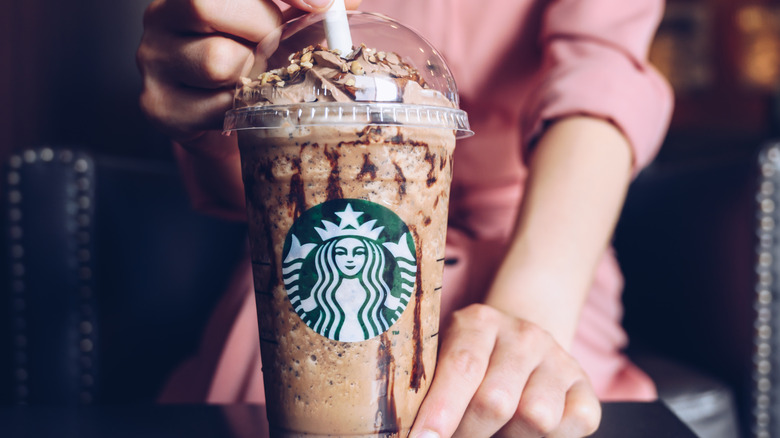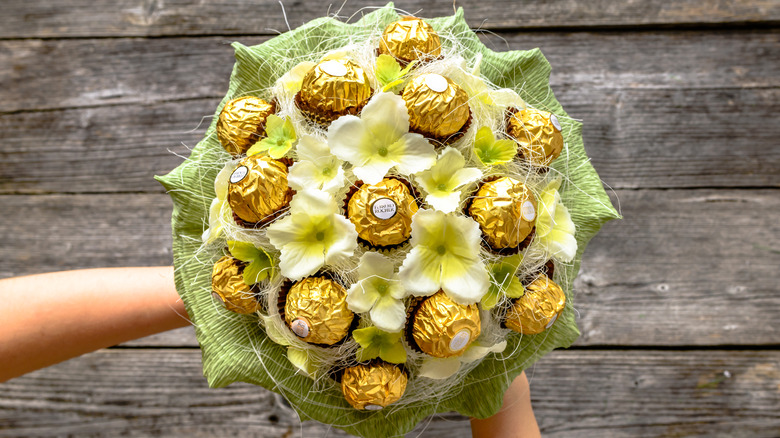The Untold Truth Of Ferrero Rocher Chocolate
Ferrero-Rocher are an Italian chocolate candy that consists of a whole, toasted hazelnut surrounded by a creamy, chocolate filling that is itself encased in a crisp, spherical wafer and then dipped in chocolate and chopped hazelnuts. They originated in Alba, a town in the northwest province of Piedmont. Piedmont means "foot of the mountain" and this section of the country predictably sits at the base of the Alps, the highest mountains of Europe.
The founder of the company that makes these delicious candies was an enterprising pastry cook named Pietro Ferrero. He invented the chocolate and hazelnut spread that came to be known as Nutella before passing the business on to his son Michele. The Ferrero family maintains control of the business to this day and Pietro's Grandson, Giovanni Ferrero, is the current Chief Executive of the company.
Alba is still home to a Ferrero factory. In fact, one-fifth of all residents of Alba are employed by the family, per the Guardian. Read on to learn the story of this famous candy.
The name is inspired by the Virgin Mary
Michele Ferrero — who inherited the Ferrero company from his father Pietro — was a devoted Catholic and when he introduced Ferrero-Rocher in 1982, he had a very specific inspiration in mind for the name. In 1858 a 14-year-old girl named Bernadette Soubirous –- a native of the town of Lourdes in France –- reported seeing visions of the Virgin Mary. She claimed to have been visited by the mother of God on 18 separate occasions and -– after some initial doubt -– clergy members came to trust her visions as genuine. Soubirous was made a saint in 1933.
This site was a lure for Ferrero who visited it as a pilgrim. The grotto where Saint Bernadette allegedly saw Mary appear to her is called the "Rocher de Massabielle." Observers believe this is the inspiration for the name of the now-famous candy. Its appearance, craggy with chopped hazelnuts, resembles the rough-textured grotto. Supposedly the whole nut in the center of the candy represents the image of the Virgin Mother that appeared to Saint Bernadette in the middle of the grotto.
Ferrero maintained a devotion to Mary for his entire life. He brought his high-level managers to Lourdes and he made sure that a statue of Mary was maintained in each one of his company's 14 production facilities.
The candies helped make Michele Ferrero the richest man in Italy
When Michele Ferrero died on Valentine's Day in 2015, he was the richest man in his country. He had made a reported fortune of over $26 billion, according to Forbes. When describing the sources of his fortune in their annual Billionaire's Report, they simply indicated "chocolates," truly all that needs to be said.
When he inherited his father's company, Michele had the bright idea to expand his reach. He specifically targeted Germany as an underserved market for the sweets. This proved to be an impressively astute move and he converted various facilities that had previously been used to make missiles and other war devices into candy factories –- a definite upgrade.
Ferrero used his vast wealth to give back and started the Fondazione Ferrero. This organization is devoted to helping seniors navigate a world that can often feel like it's leaving them behind. This foundation is based in the family's hometown of Alba and has inspired similar organizations in other countries as well.
The candies come gilded and often in spectacular packaging
One of the most notable and iconic aspects of Ferrero-Rocher is the luxe packaging the candies come in. Wrapped in gold foil and individually portioned in fluted paper cups, the chocolates look distinctly luxe. That's by design and its makers love that it is associated with luxe living.
The individually wrapped candies are often sold in large format packaging that is designed to highlight the gold aspect as much as possible. Clear plastic boxes –- which these days are much more eco-friendly than they used to be, according to Confectionery News –- show off the gold foil and allow for a sneak peek of what is to come.
One of the most spectacular packaging options is the Grand Ferrero-Rocher which amounts to a giant chocolate and hazelnut shell that gets cracked open only to reveal multiple regularly-sized chocolates inside. Other options include holiday-specific packaging that typically includes the company's signature gold theme.
Over 60% of sales take place in the final three months of the year
Ferrero-Rocher inherently lends itself to a celebration, what with the gold packaging and premium product inside. This means the candies are a natural fit for the end-of-year holiday season. It's often featured on various lists of last-minute gifts for people you may have forgotten about, especially since it's not only delicious, but widely available.
The company capitalizes on this trend by releasing special edition packaging and promotions for Christmas. These treats are often the same as the regular candies but dressed up in holiday-appropriate packaging. Talking Retail explains that Ferrero-Rocher has come to be a beloved -– and lucrative –- part of many holiday traditions. After all, who wouldn't want an Advent Calendar stuffed with gold-wrapped treats?
One particularly spectacular example that gets released for the holiday season is an enormous Ferrero-Rocher that weighs a whopping 500 grams (just over one pound). This huge candy still only has a single hazelnut in its center but the sheer size and scope of it is surely enough to turn heads and make any spirit bright.
A commercial from the '90s is both cheesy and fondly remembered
In a faraway time known as the 1990s, a more ... innocent vibe reigned. When looking back on media from the time many observers find it unavoidable to cringe over what feels like a different world. From frosted tips, to vinyl windbreakers to iconic television and movie memories, the 20th Century ended with a bang.
In part because of nostalgic '90s kids, Ferrero-Rocher's commercial has racked up hundreds of thousands of views online. In the 30 second ad, you are shown a dazzling party at an embassy, where you are introduced to a mysteriously accented woman telling "Monsieur Ambassador" that he was spoiling the party-goers with his generous gift of Ferrero-Rocher, lavishly served in a towering pyramid. It's pretty fun stuff.
To this day the Ferrero family maintains that they weren't being over the top in their depiction of the level of status that their chocolate candies rate and that an ambassador serving their chocolates at an affair of state was only to be expected.
As it turns out, they were right and the Italian Ambassador to the United Kingdom really did serve Ferrero-Rochet chocolates to guests at his embassy in London. Radio Times quotes Ambassador Pasquale Terracciano as saying "I was a bit wary at the beginning because of the cliché, [...] but then people asked for them –- and they are good, so ..."
The company has become a major player in the international candy market
Ferrero has grown larger and larger over the years. The company has been involved in several business acquisitions and deals, including a failed attempt at preventing Kraft from taking ownership of the U.K.'s Cadbury chocolate company.
Other acquisitions over the years have included various brands previously owned by Kellog such as Keebler and Famous Amos (according to Business Insider). In addition, it has also absorbed Thornton's chocolates in the U.K. and the rights to make some of the Girl Scout cookies in the States. The company has come very far from its quiet, Alpine origins
One of the largest takeovers executed by the Ferrero family was the 2018 deal that saw chocolate giant Nestle sell most of its confectionery rights in the U.S. to Ferrero. This complicated deal means that Ferrero now produces things like Butterfingers, BabyRuth, and Crunch bars in the U.S. – but nowhere else. Other Nestle properties such as Kit-Kat and the Toll House line of baking products remained with the Swiss company (per USA Today).
It is filled with everyone's favorite nut and chocolate spread - Nutella!
The creamy layer of filling within the spherical wafer is none other than the best thing to happen to morning toast. The rich, melting texture of the interior is a perfect foil to the crispness of the wafer and the crunchy hazelnuts. It does make sense that the makers of such a delicious product would find a way to work it into as many of its products as possible.
Nutella is a spreadable paste made of ground hazelnuts, palm oil, and cocoa powder. The current version of Nutella dates from 1964 and has been taking the world by storm ever since. It has spawned a legion of devoted fans the world over. Sales of the spread are assisted by the fact that it has no significant competitor in its niche (per Food Dive.)
It's so popular that over 365,000 tons of Nutella are produced every year. France consumes the most of any country, according to Culture Trip. It follows that the French eat a quarter of the Nutella produced in the world, considering they invented the crepe and there is nothing quite like a freshly made crepe rolled around some Nutella. Yum.
The addition of hazelnuts came from war shortages
Pietro Ferrero was the visionary behind all of this. Forbes explains how he settled into Alba after a brief stint in Eastern Africa in the 1930s to try and supply baked goods to the Italian soldiers stationed there. Once back in his native Piedmont he tried to make the best of the shortages of wartime Italian supplies and decided to try to cut some of the cocoa –- which was hard to get and expensive -– with a more easily obtainable substitute.
The original was a more solid mixture that Ferrero sold in blocks to Italians excited to have a treat in the midst of the war. Once the war ended and Italy put itself back together again, he was able to build a steady and successful business. His brother, Giovanni, had a history in the food wholesale business and he helped his brother put together his organization.
When Pietro died of a heart attack in 1949, his brother and his son, Michele, carried on the legacy. That same year they released what why called "Supercrema" –- what was later to transform into Nutella as we know it.
The combination of chocolate and hazelnuts is an Italian classic
Pietro's invention, which he called "Giandujot" was not without precedent. Chocolate Class explains how this was itself a riff on an Italian confection called Gianduja.
Gianduja is also a child of necessity and it traces its origins to the same Italian province of Piedmont. During Napoleon Bonaparte's ascendency in France he came to dominate Italy. In vying with the British for supremacy, Napoleon instituted a ban on all trade between the rest of the nations of Europe and Great Britain. This was referred to as the Continental System and it made it very difficult to acquire goods not produced on mainland Europe, including, crucially, chocolate and cocoa. Or at least that's what most sources say.
Serious Eats rebuts that and explains how the technology available at the time would not have been sufficient to make such a finely textured paste commercially viable. They cite food historian Ken Albala and give credit to the French influence over Italy at the time for this particular combination.
Whatever the real story is, we can all be grateful for the results: a delicious and timeless combination.
The Rocher Company uses a quarter of the world's hazelnuts
When you have a small empire built around hazelnuts that means you need access to an awful lot of them to sustain it. NPR outlines how the huge demand for the Ferrero company's products has caused Italy to be unable to supply enough domestically to satisfy it.
Instead, most hazelnuts –- sometimes called filberts –- that supply the production of Ferrero-Rocher come from Turkey. A small tract of land along the Black Sea has hosted hazelnut farmers for thousands of years but the huge and booming demand for hazelnuts has caused prices to steadily rise and companies, including Ferrero, to search farther afield to maintain its production levels.
Until recently, hazelnut production in North America has proved completely untenable thanks to a native fungus that causes a disease in the Old World version of the tree called Eastern Filbert Blight. Researchers have been able to inoculate hazelnut trees against this pest by grafting them with native roots, which have long since acquired an immunity. These native trees do not produce hazelnuts of the same quality as those expected by Europeans.
The company has run into some controversy regarding its potential use of child labor
The Guardian details reports about many questions raised by the standard practice of hazelnut farmers in Turkey, many of whom employ children as young as six years old. Representatives of the company have insisted that they hold themselves to high ethical standards, but they also admit that they can't ensure the provenance that all of the nuts they buy are 100% child labor free.
This is just one more example of a trend of questionable practices of various confectionery companies. Food Is Power explains how much of the world's chocolate supply comes from regions in West Africa that rely on compelled child labor which amounts to virtual slavery.
In a disappointing example of valuing profits over people, many chocolate companies turn a blind eye to such accusations and continue to profit off the inherent iniquity of child labor. Some ethical producers, like Tony's Chocolonely, insist that only a general resolve to source cocoa beans strictly from farmers who take care of their labor force can permanently stamp out the practice of child labor (per Forbes.)
There are other varieties besides the milk chocolate and hazelnut standard
Ferrero's website lists two other types of candies in the same style and size: Rocher Rondnoir and Confetteria Raffaello. Rocher Rondoir is a love letter to chocolate. In addition to the Ferrero signature crisp, round wafer and coating of chocolate -– although it is dark chocolate in this instance -– the interior of the Rondnoir contains no hazelnuts, but only more chocolate. This includes a sphere of silky dark chocolate in the center — in place of the standard hazelnut –- that the company calls its "precious pearl."
Confetteria Raffaello is an even greater departure from the original and doesn't even contain chocolate. Instead, a creamy filling surrounds an almond center. This is encased in a round wafer and coated in flaked coconut. This combination is also featured in white chocolate bars and even ice cream, according to Raffaello itself.
Some gift packs combine all three types of candies in a variety pack that usually features the glitz and glamor that most people expect from a Ferrero product.
The candy has inspired a secret menu Frappuccino
If chocolate and hazelnuts are already delicious together, then what's the harm in adding something else to improve it further? Perhaps at an internationally known coffee chain? As Delish explains, a drink inspired by the flavor combination of a Ferrero-Rocher is very achievable –- though you won't find it on the regular menu.
Enterprising fans of both Starbucks and Ferrero-Rocher have figured out a way to combine existing flavorings at the coffee chain –- including chocolate, hazelnut, and caramel –- to achieve a remarkable replication of the gold-covered chocolates.
Several websites exist to document all the possible "secret menu" options available at Starbucks. Proving that you don't need to rely on the creativity of a corporate chain, superfans have cataloged hundres of possibilities for an adventurous caffeine junkie. For those that would want to drink their Ferrro-Rocher but prefer to avoid the jitters, you can follow the Thirsty Feast's lead and make a milkshake with all the flavors of the candy. The lesson here is that it's hard to go wrong when combining chocolate, hazelnuts, and sugar.
It is an aspirational candy, especially for immigrants
For immigrants to the United States, the luxury of a box of Ferrero-Rocher has served as a tiny little fulfillment of the American dream so many of them came seeking (per Thrillist).
The indulgence of these premium chocolates –- gold wrapped and in deluxe packaging –- was a sign of the upward mobility sought by many Iranian, Libyan, and Armenian refugees. Seeking stability and fleeing dangerous circumstances back home, these families settled in the United States where they maintained their traditions of generous and open hospitality in their new country.
The act of offering guests a bowl of Ferrero-Rocher was a representation of that generosity. The chocolates were high status but -– crucially -– obtainable. Many second-generation citizens lovingly describe the way the presence of these golden spheres signaled a special occasion for their families (corroborated by the San Francisco Chronicle.)
The aspirational aspect of Ferrero-Rocher is part of its identity. Whether it's an ambassador's guests or war-weary Italians or coffee fans or Middle Eastern immigrants, all can appreciate the charm of these tasty, sweet treats.
